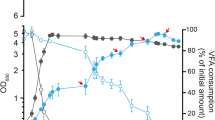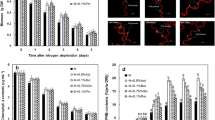Abstract
Polyhydroxybutyrate (PHB) is an important biopolymer accumulated by bacteria and associated with cell survival and stress response. Here, we make two surprising findings in the PHB-accumulating species Rhodospirillum rubrum S1. We first show that the presence of PHB promotes the increased assimilation of acetate preferentially into biomass rather than PHB. When R. rubrum is supplied with 13C-acetate as a PHB precursor, 83.5 % of the carbon in PHB comes from acetate. However, only 15 % of the acetate ends up in PHB with the remainder assimilated as bacterial biomass. The PHB-negative mutant of R. rubrum assimilates 2-fold less acetate into biomass compared to the wild-type strain. Acetate assimilation proceeds via the ethylmalonyl-CoA pathway with (R)-3-hydroxybutyrate as a common intermediate with the PHB pathway. Secondly, we show that R. rubrum cells accumulating PHB have reduced ribulose 1,5-bisphosphate carboxylase (RuBisCO) activity. RuBisCO activity reduces 5-fold over a 36-h period after the onset of PHB. In contrast, a PHB-negative mutant maintains the same level of RuBisCO activity over the growth period. Since RuBisCO controls the redox potential in R. rubrum, PHB likely replaces RuBisCO in this role. R. rubrum is the first bacterium found to express RuBisCO under aerobic chemoheterotrophic conditions.




Similar content being viewed by others
References
(2015) KEGG. Publisher. http://www.genome.jp/dbget-bin/www_bfind?T00310
Alber BE, Spanheimer R, Ebenau-Jehle C, Fuchs G (2006) Study of an alternate glyoxylate cycle for acetate assimilation by Rhodobacter sphaeroides. Mol Microbiol 61(2):297–309. doi:10.1111/J.1365-2958.2006.05238.X
Arias S, Bassas-Galia M, Molinari G, Timmis KN (2013) Tight coupling of polymerization and depolymerization of polyhydroxyalkanoates ensures efficient management of carbon resources in Pseudomonas putida. Microb Biotechnol 6(5):551–563. doi:10.1111/1751-7915.12040
Basak N, Das D (2007) The prospect of purple non-sulfur (PNS) photosynthetic bacteria for hydrogen production: the present state of the art. World J Microbiol Biotechnol 23(1):31–42. doi:10.1007/s11274-006-9190-9
Bentley R (2000) From ‘reactive C-2 units’ to acetyl coenzyme A: a long trail with an acetyl phosphate detour. Trends Biochem Sci 25(6):302–305. doi:10.1016/S0968-0004(00)01590-5
Berg JM, Tymoczko JL, Stryer L (2002) Biochemistry, Fifth edn. W. H. Freeman and Company, New York
Bose SK, Gest H, Ormerod JG (1961) Light-activated hydrogenase activity in a photosynthetic bacterium—a permeability phenomenon. J Biol Chem 236(3):PC13–PC14
Brandl H, Knee EJ, Fuller RC, Gross RA, Lenz RW (1989) Ability of the phototrophic bacterium Rhodospirillum rubrum to produce various poly (beta-hydroxyalkanoates)—potential sources for biodegradable polyesters. Int J Biol Macromol 11(1):49–55. doi:10.1016/0141-8130(89)90040-8
Cagney G, Park S, Chung C, Tong B, O’Dushlaine C, Shields DC, Emili A (2005) Human tissue profiling with multidimensional protein identification technology. J Proteome Res 4(5):1757–1767. doi:10.1021/Pr0500354
Carius AB, Henkel M, Grammel H (2011) A glutathione redox effect on photosynthetic membrane expression in Rhodospirillum rubrum. J Bacteriol 193(8):1893–1900. doi:10.1128/JB.01353-10
Carius L, Carius AB, McIntosh M, Grammel H (2013) Quorum sensing influences growth and photosynthetic membrane production in high-cell-density cultivations of Rhodospirillum rubrum. BMC Microbiol 13. doi:10.1186/1471-2180-13-189
Cook LS, Im H, Tabita FR (1988) Oxygen-dependent inactivation of ribulose 1,5-bisphosphate carboxylase oxygenase in crude extracts of Rhodospirillum rubrum and establishment of a model inactivation system with purified enzyme. J Bacteriol 170(12):5473–5478
Cox J, Mann M (2008) MaxQuant enables high peptide identification rates, individualized p.p.b.-range mass accuracies and proteome-wide protein quantification. Nat Biotechnol 26(12):1367–1372. doi:10.1038/nbt.1511
Cox J, Neuhauser N, Michalski A, Scheltema RA, Olsen JV, Mann M (2011) Andromeda: a peptide search engine integrated into the MaxQuant environment. J Proteome Res 10(4):1794–1805. doi:10.1021/Pr101065j
Do YS, Smeenk J, Broer KM, Kisting CJ, Brown R, Heindel TJ, Bobik TA, DiSpirito AA (2007) Growth of Rhodospirillum rubrum on synthesis gas: conversion of CO to H2 and poly-beta-hydroxyalkanoate. Biotechnol Bioeng 97(2):279–286. doi:10.1002/bit.21226
Eggers J, Steinbüchel A (2014) Impact of Ralstonia eutropha’s poly(3-hydroxybutyrate) (PHB) depolymerases and phasins on PHB storage in recombinant Escherichia coli. Appl Environ Microbiol 80(24):7702–7709. doi:10.1128/Aem.02666-14
Eisenberg MA (1953) The tricarboxylic acid in Rhodospirillum rubrum. J Biol Chem 203(2):815–836
Erb TJ, Berg IA, Brecht V, Müller M, Fuchs G, Alber BE (2007) Synthesis of C5-dicarboxylic acids from C2-units involving crotonyl-CoA carboxylase/reductase: the ethylmalonyl-CoA pathway. Proc Natl Acad Sci U S A 104(25):10631–10636. doi:10.1073/pnas.0702791104
Erb TJ, Brecht V, Fuchs G, Müller M, Alber BE (2009a) Carboxylation mechanism and stereochemistry of crotonyl-CoA carboxylase/reductase, a carboxylating enoyl-thioester reductase. Proc Natl Acad Sci U S A 106(22):8871–8876. doi:10.1073/pnas.0903939106
Erb TJ, Fuchs G, Alber BE (2009b) (2S)-Methylsuccinyl-CoA dehydrogenase closes the ethylmalonyl-CoA pathway for acetyl-CoA assimilation. Mol Microbiol 73(6):992–1008. doi:10.1111/j.1365-2958.2009.06837.x
Escapa IF, Garcia JL, Buhler B, Blank LM, Prieto MA (2012) The polyhydroxyalkanoate metabolism controls carbon and energy spillage in Pseudomonas putida. Environ Microbiol 14(4):1049–1063. doi:10.1111/j.1462-2920.2011.02684.x
Gordon GC, McKinlay JB (2014) Calvin cycle mutants of photoheterotrophic purple nonsulfur bacteria fail to grow due to an electron imbalance rather than toxic metabolite accumulation. J Bacteriol 196(6):1231–1237. doi:10.1128/JB.01299-13
Grage K, Peters V, Palamisany R, Rehm BH (2009) Polyhydroxyalkanoates: from bacterial storage compound via renewable plastic bio-bead. In: Rehm BH (ed) Microbial production of polymers and polymer precursors: applications and perspectives. Causter Academic Press, Norfolk, UK, pp. 255–289
Grammel H, Gilles ED, Ghosh R (2003) Microaerophilic cooperation of reductive and oxidative pathways allows maximal photosynthetic membrane biosynthesis in Rhodospirillum rubrum. Appl Environ Microbiol 69(11):6577–6586. doi:10.1128/Aem.69.11.6577-6586.2003
Green J, Paget MS (2004) Bacterial redox sensors. Nat Rev Microbiol 2(12):954–966. doi:10.1038/Nrmicro1022
Hauf W, Schlebusch M, Hüge J, Kopka J, Hagemann M, Forchhammer K (2013) Metabolic changes in Synechocystis PCC6803 upon nitrogen starvation: excess NADPH sustains polyhydroxybutyrate accumulation. Metabolites 3(1):101–118. doi:10.3390/metabo3010101
Haywood GW, Anderson AJ, Chu L, Dawes EA (1988) The role of NADH-linked and NADPH-linked acetoacetyl-CoA reductases in the poly-3-hydroxybutyrate synthesizing organism Alcaligenes eutrophus. FEMS Microbiol Lett 52(3):259–264. doi:10.1111/J.1574-6968.1988.Tb02607.X
Huang Da W, Sherman BT, Lempicki RA (2009) Bioinformatics enrichment tools: paths toward the comprehensive functional analysis of large gene lists. Nucleic Acids Res 37(1):1–13. doi:10.1093/nar/gkn923
Imhoff JF, Trüper HG (1992) The genus Rhodospirillum and related genera. In: Balows A, Trüper HG, Dworkin M, Harder W, Schleifer K-H (eds) Prokaryotes, 2nd edn. Berlin, Heidelberg, New York, Springer., pp. 2141–2155
Jendrossek D, Pfeiffer D (2014) New insights in the formation of polyhydroxyalkanoate granules (carbonosomes) and novel functions of poly(3-hydroxybutyrate). Environ Microbiol 16(8):2357–2373. doi:10.1111/1462-2920.12356
Kanemoto RH, Ludden PW (1987) Amino acid concentrations in Rhodospirillum rubrum during expression and switch-off of nitrogenase activity. J Bacteriol 169(7):3035–3043
Kennedy EP (2001) Hitler’s gift and the era of biosynthesis. J Biol Chem 276(46):42619–42631. doi:10.1074/Jbc.R100051200
Klask C, Raberg M, Heinrich D, Steinbüchel A (2015) Heterologous expression of various PHA synthase genes in Rhodospirillum rubrum. Chem Biochem Eng Q 29(2):75–85
Kleijn RJ, Buescher JM, Le Chat L, Jules M, Aymerich S, Sauer U (2010) Metabolic fluxes during strong carbon catabolite repression by malate in Bacillus subtilis. J Biol Chem 285(3):1587–1596. doi:10.1074/Jbc.M109.061747
Koller M, Bona R, Hermann C, Horvat P, Martinz J, Neto J, Pereira L, Varila P, Braunegg G (2005) Biotechnological production of poly(3-hydroxybutyrate) with Wautersia eutropha by application of green grass juice and silage juice as additional complex substrates. Biocatal Biotransfor 23(5):329–337. doi:10.1080/10242420500292252
Kornberg HL, Lascelles J (1960) The formation of isocitratase by the Athiorhodaceae. J Gen Microbiol 23(3):511–517
Lageveen RG, Huisman GW, Preusting H, Ketelaar P, Eggink G, Witholt B (1988) Formation of polyesters by Pseudomonas oleovorans: effect of substrates on formation and composition of poly-(R)-3-hydroxyalkanoates and poly-(R)-3-hydroxyalkenoates. Appl Environ Microbiol 54(12):2924–2932
Laguna R, Tabita FR, Alber BE (2011) Acetate-dependent photoheterotrophic growth and the differential requirement for the Calvin-Benson-Bassham reductive pentose phosphate cycle in Rhodobacter sphaeroides and Rhodopseudomonas palustris. Arch Microbiol 193(2):151–154. doi:10.1007/S00203-010-0652-Y
Leustek T, Hartwig R, Weissbach H, Brot N (1988) Regulation of ribulose bisphosphate carboxylase expression in Rhodospirillum rubrum: characteristics of messenger RNA synthesized in vivo and in vitro. J Bacteriol 170(9):4065–4071
Lüderitz R, Klemme JH (1977) Isolation and characterization of a membrane-bound pyruvate-dehydrogenase complex from phototropic bacterium Rhodospirillum rubrum. Z Naturforsch C J Biosci 32(5–6):351–361
Madison LL, Huisman GW (1999) Metabolic engineering of poly(3-hydroxyalkanoates): from DNA to plastic. Microbiol Mol Biol R 63(1):21−+
Meijer WG, Dijkhuizen L (1988) Regulation of autotrophic metabolism in Pseudomonas oxalaticus OX1 wild-type and an isocitrate-lyase-deficient mutant. J Gen Microbiol 134:3231–3237
Munk AC, Copeland A, Lucas S, Lapidus A, Del Rio TG, Barry K, Detter JC, Hammon N, Israni S, Pitluck S, Brettin T, Bruce D, Han C, Tapia R, Gilna P, Schmutz J, Larimer F, Land M, Kyrpides NC, Mavromatis K, Richardson P, Rohde M, Goker M, Klenk HP, Zhang YP, Roberts GP, Reslewic S, Schwartz DC (2011) Complete genome sequence of Rhodospirillum rubrum type strain (S1(T)). Stand Genomic Sci 4(3):293–302. doi:10.4056/Sigs.1804360
Ormerod JG, Gest H, Ormerod KS (1961) Light-dependent utilization of organic compounds and photoproduction of molecular hydrogen by photosynthetic bacteria—relationships with nitrogen metabolism. Arch Biochem Biophys 94(3):449-&. doi:10.1016/0003-9861(61)90073-X
Pearce FG (2006) Catalytic by-product formation and ligand binding by ribulose bisphosphate carboxylases from different phylogenies. Biochem J 399:525–534. doi:10.1042/Bj20060430
Pham TH, Webb JS, Rehm BH (2004) The role of polyhydroxyalkanoate biosynthesis by Pseudomonas aeruginosa in rhamnolipid and alginate production as well as stress tolerance and biofilm formation. Microbiol SGM 150(Pt 10):3405–3413. doi:10.1099/mic.0.27357-0
Raberg M, Voigt B, Hecker M, Steinbüchel A (2014) A closer look on the polyhydroxybutyrate- (PHB-) negative phenotype of Ralstonia eutropha PHB(−)4. Plos One 9(5) ARTN e95907. doi:10.1371/journal.pone.0095907
Reid CD, Tissue DT, Fiscus EL, Strain BR (1997) Comparison of spectrophotometric and radioisotopic methods for the assay of Rubisco in ozone-treated plants. Physiol Plant 101(2):398–404. doi:10.1111/j.1399-3054.1997.tb01014.x
Rudolf C, Grammel H (2012) Fructose metabolism of the purple non-sulfur bacterium Rhodospirillum rubrum: effect of carbon dioxide on growth, and production of bacteriochlorophyll and organic acids. Enzym Microb Technol 50(4–5):238–246. doi:10.1016/j.enzmictec.2012.01.007
Scheiner D (1976) Determination of ammonia and Kjeldahl nitrogen by indophenol method. Water Res 10(1):31–36. doi:10.1016/0043-1354(76)90154-8
Selao TT, Edgren T, Wang H, Noren A, Nordlund S (2011) Effect of pyruvate on the metabolic regulation of nitrogenase activity in Rhodospirillum rubrum in darkness. Microbiol SGM 157:1834–1840. doi:10.1099/Mic.0.045831-0
Smith RL, West TP, Gibbons WR (2008) Rhodospirillum rubrum: utilization of condensed corn solubles for poly-(3-hydroxybutyrate-co-3-hydroxyvalerate) production. J Appl Microbiol 104(5):1488–1494. doi:10.1111/j.1365-2672.2007.03685.x
Steinbüchel A, Lütke-Eversloh T (2003) Metabolic engineering and pathway construction for biotechnological production of relevant polyhydroxyalkanoates in microorganisms. Biochem Eng J 16(2):81–96. doi:10.1016/S1369-703x(03)00036-6
Uchino K, Saito T, Gebauer B, Jendrossek D (2007) Isolated poly(3-hydroxybutyrate) (PHB) granules are complex bacterial organelles catalyzing formation of PHB from acetyl coenzyme A (CoA) and degradation of PHB to acetyl-CoA. J Bacteriol 189(22):8250–8256. doi:10.1128/Jb.00752-07
Verlinden RAJ, Hill DJ, Kenward MA, Williams CD, Radecka I (2007) Bacterial synthesis of biodegradable polyhydroxyalkanoates. J Appl Microbiol 102(6):1437–1449. doi:10.1111/j.1365-2672.2007.03335.x
Wang WX, Zhou HH, Lin H, Roy S, Shaler TA, Hill LR, Norton S, Kumar P, Anderle M, Becker CH (2003) Quantification of proteins and metabolites by mass spectrometry without isotopic labeling or spiked standards. Anal Chem 75(18):4818–4826. doi:10.1021/Ac026468x
Zhao YH, Li HM, Qin LF, Wang HH, Chen GQ (2007) Disruption of the polyhydroxyalkanoate synthase gene in Aeromonas hydrophila reduces its survival ability under stress conditions. FEMS Microbiol Lett 276(1):34–41. doi:10.1111/j.1574-6968.2007.00904.x
Author information
Authors and Affiliations
Corresponding author
Ethics declarations
This article does not contain any studies with human participants or animals performed by any of the authors.
Funding information
This work was funded by the European Commission’s The Seventh Framework Programme project SYNPOL (311815).
Conflict of interest
The authors declare that they have no conflict of interest.
Additional information
Tanja Narancic and Elisa Scollica contributed equally to this work.
Electronic supplementary material
ESM 1
(PDF 1285 kb)
Rights and permissions
About this article
Cite this article
Narancic, T., Scollica, E., Kenny, S.T. et al. Understanding the physiological roles of polyhydroxybutyrate (PHB) in Rhodospirillum rubrum S1 under aerobic chemoheterotrophic conditions. Appl Microbiol Biotechnol 100, 8901–8912 (2016). https://doi.org/10.1007/s00253-016-7711-5
Received:
Accepted:
Published:
Issue Date:
DOI: https://doi.org/10.1007/s00253-016-7711-5




